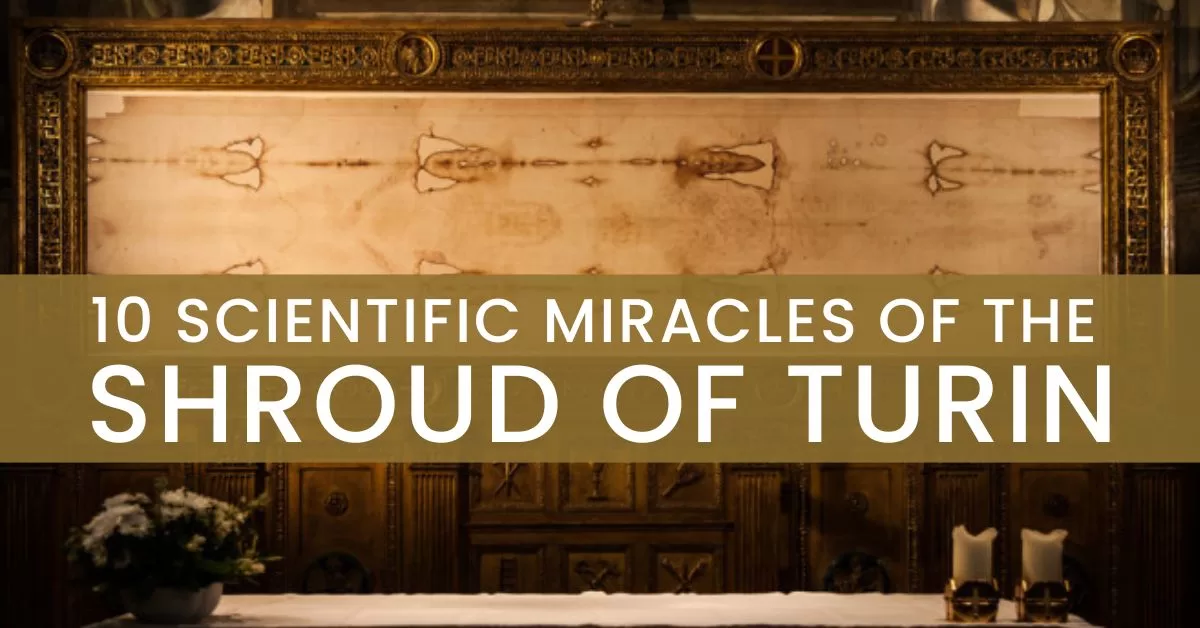I recently rediscovered this seemingly mystical artifact that was said to have once wrapped the body of our crucified Christ.
I remember hearing about this back in grade school and I dismissed it because I figured there was no way they would have this ancient cloth from that long ago.
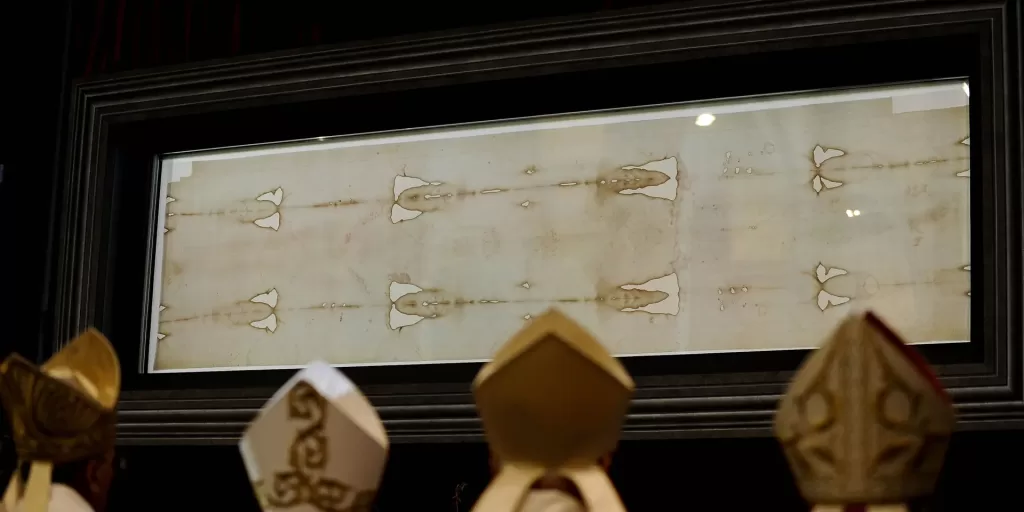
The earliest documented references to a shroud resembling that in Turin, Italy appear around the mid-14th century in Lirey, France, associated with the knight Geoffroi de Charny. It was subsequently displayed in various chapels and cathedrals since then.
I mean, I really wanted to believe it but you know what they say, somethings are just too good to be true. But isn’t God amazing?
His word and His promises are preserved and to those that want to believe in something unbelievable, I would encourage you to check this out… these are 10 scientific miracles of the Shroud of Turin.
- 3D Encoding: The Shroud of Turin contains depth information which allows for a three-dimensional reconstruction of the shape of the face and body it purportedly covered. This property is not known to exist in any other medieval artworks.
- Photographic Negativity: The image on the Shroud is a negative image, with the lights and darks reversed. This characteristic was not recognized until the advent of modern photography in the 19th century.
- Microscopic Traces of Soil and Pollen: Pollen grains and soil samples found on the Shroud are consistent with plants and earth from the Jerusalem area, supporting the shroud’s historical journey as described in religious texts.
- Anatomical Accuracy: The image on the Shroud shows anatomical correctness and detailed realism in the depiction of the human form, including accurate blood flow from wounds, rigor mortis, and wounds consistent with crucifixion.
- Blood Stains: The Shroud shows marks that are consistent with a crown of thorns, scourging, and crucifixion. The bloodstains contain high levels of bilirubin, which is consistent with someone who suffered physical trauma.
- Lack of Directional Brush Strokes: Microscopic examinations of the Shroud have not revealed any evidence of brush strokes, as would be typical in a painted image.
- Image Formation: Despite numerous studies, the exact mechanism of the image formation remains unclear, leading some to suggest it was formed through some kind of radiation or a burst of energy.
- The Cloth’s Weaving and Material: The Shroud is made of herringbone twill composed of flax fibrils, a complex weave not typical of common medieval textiles.
- Chemical Makeup: The image parts of the Shroud contain degraded cellulose, indicative of an oxidative reaction, not typical paint materials. The nature of the image formation is still not reproducible with known technologies.
- Consistency with Roman Crucifixion Methods: The positioning of the nails in the wrists and feet, as depicted on the Shroud, align with Roman crucifixion methods rather than medieval depictions, which often inaccurately show nails through the palms.
Let’s break it down further.
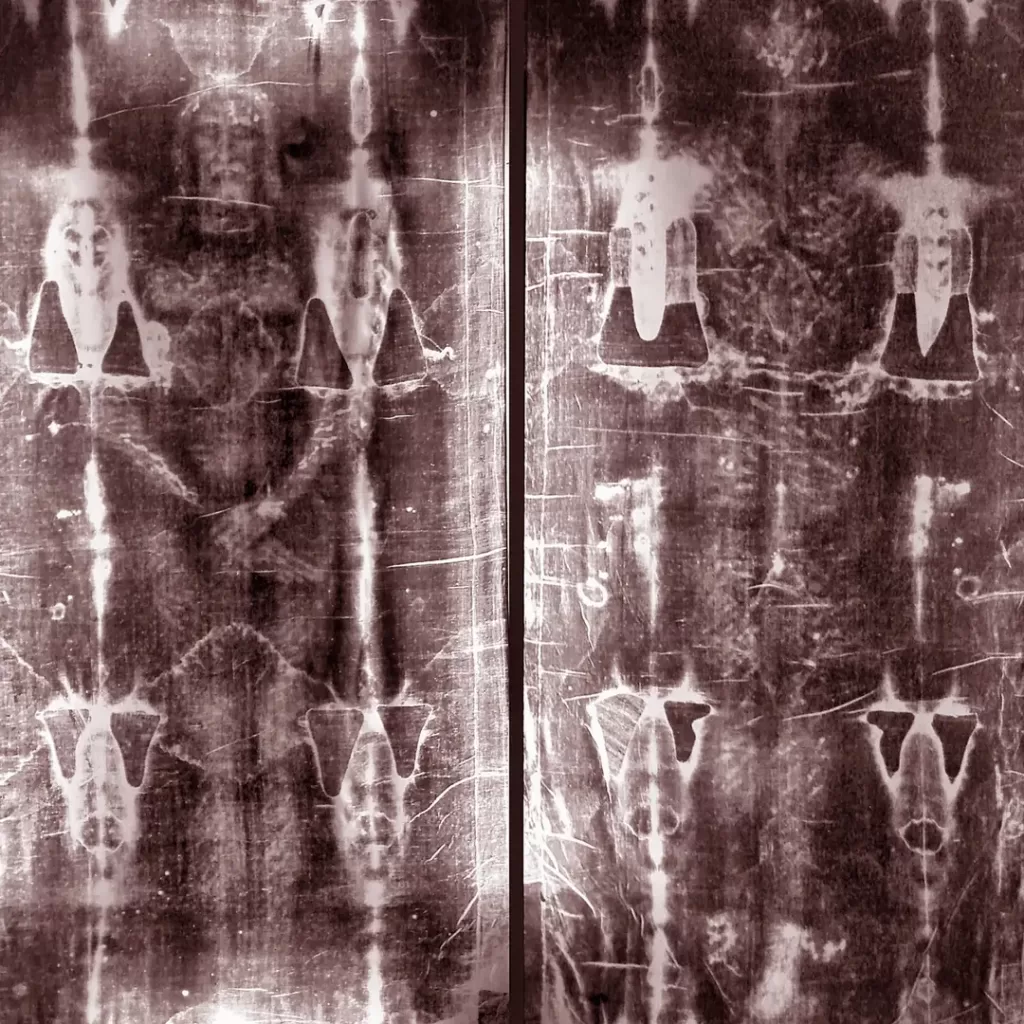
#1 3D Encoding
The 3D encoding on the Shroud of Turin is one of the most intriguing aspects of this artifact.
What is 3D Encoding?
The concept of “3D encoding” refers to the idea that the intensity of the image on the Shroud varies in a way that correlates with the distance from the cloth to the body it would have covered. This means that the image possesses depth information which enables the construction of a three-dimensional representation of the shape of the face and body it allegedly wrapped.
How Was It Discovered?
This property was discovered in 1976 when researchers John Jackson, Eric Jumper, and Bill Mottern used a device called the VP-8 Image Analyzer, which was developed for NASA to create brightness maps of the moon. When they applied this technology to the Shroud, they found that, unlike any normal photograph or painting, the image’s luminance did not correspond to pigment density but rather to the distance from the cloth to the body.
Implications of 3D Encoding
- Depth Information:
- The VP-8 analysis revealed that areas where the cloth would have been in closer contact with the body (such as the nose or chin) are darker, while areas with greater distance (like the sides of the face) are lighter. This is opposite of what would be expected in a traditional painting or photograph, where color and luminance are controlled by the artist’s application of pigments.
- Uniqueness:
- No other ancient or medieval artworks demonstrate this kind of depth information. This uniqueness has fueled arguments both for and against the Shroud’s authenticity. Proponents argue that no medieval artist would have known about or been able to reproduce such an effect, suggesting the image was formed by some kind of natural process or miraculous event.
- Challenges in Replication:
- Researchers and artists have attempted to replicate the effect using various artistic and photographic techniques, but to date, no one has been able to duplicate fully the depth-coding features using medieval technologies. This inability to replicate the Shroud’s 3D effect continues to puzzle scientists and historians.
- Scientific and Artistic Interest:
- The 3D encoding adds a layer of complexity to the study of the Shroud. It intersects fields of image analysis, forensics, fabric analysis, and historical investigation, making it a subject of interdisciplinary research.
The phenomenon of 3D encoding on the Shroud of Turin remains one of its most compelling and mysterious features. It challenges our understanding of medieval art and opens up debates about the capabilities of non-modern technologies and the nature of this enigmatic artifact. Whether viewed as a feature of a sacred relic or a subject of scientific intrigue, the 3D properties of the Shroud continue to engage both believers and skeptics alike.
Sources for 3D encoding:
https://shroud3d.com/introduction/3d-studies-of-the-shroud-of-turin-history/
https://www.raydowning.com/blog/2016/2/15/the-3d-information-on-the-shroud-of-turin
#2 Photographic Negativity
The second phenomenon of the Shroud of Turin, “Photographic Negativity,” is another compelling aspect that has puzzled researchers and stirred considerable debate.
What is Photographic Negativity?
Photographic negativity refers to the property of the Shroud’s image being a negative rather than a positive image. In photography, a negative image is produced where light areas appear dark and dark areas appear light. This property was unnoticed until the advent of photography in the 19th century when the first photograph of the Shroud was taken by Secondo Pia in 1898.
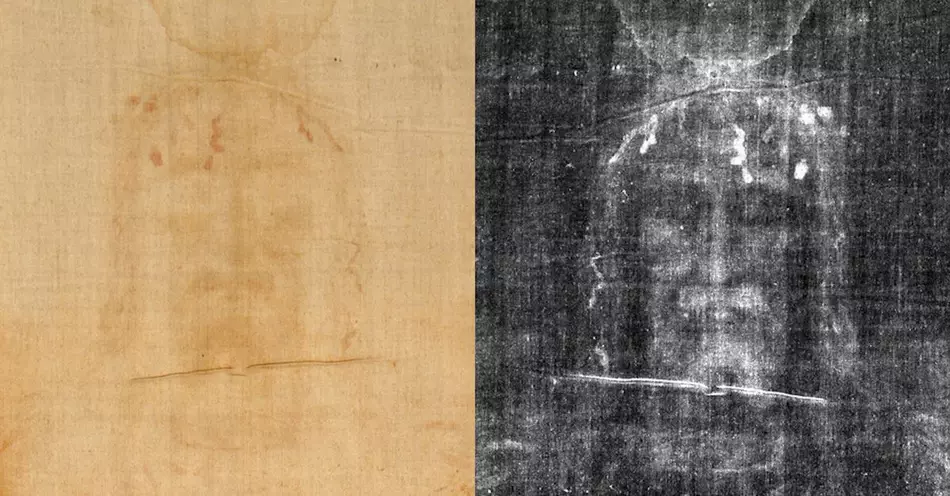
Discovery and Initial Reaction
- Discovery by Secondo Pia: When Pia photographed the Shroud, he was startled to see a clearer, positive image appear on his photographic plate, essentially inverting the Shroud’s negative image into a positive one. This was unexpected because the human eye perceives the Shroud’s image as faint and somewhat indistinct, and traditional artworks typically do not display such characteristics.
- Public and Scientific Impact: The discovery was groundbreaking because it suggested that the Shroud’s image was formed in a manner uncharacteristic of human artistic methods known at the time. It introduced a scientific mystery regarding how such an image could have been produced.
Implications of Photographic Negativity
- Challenge to Artistic Origin:
- If the Shroud were a medieval painting, as some skeptics suggest, the use of photographic negative imaging would be anachronistically advanced for the artists of the time. This property led many to speculate about the method of the image’s formation, suggesting that it wasn’t painted but rather formed through some other unknown process.
- Enhanced Detail and Realism:
- The negative image on the Shroud allows for more realistic and detailed visualization when converted into a positive image. Features such as the anatomical correctness of the face, wounds, and the subtlety of the shading become more distinct and realistic in the positive image, suggesting a detailed knowledge of human anatomy and pathology that would be unusual for medieval artistry.
- Interdisciplinary Interest:
- This phenomenon has drawn interest from photographers, forensic experts, and imaging specialists aiming to understand how an image could have both formed naturally on a linen cloth and possess intrinsic photographic properties without the intervention of light-sensitive chemicals known to be used in modern photography.
The photographic negativity of the Shroud of Turin not only challenges our understanding of medieval capabilities but also enhances the depth of investigation into the Shroud’s origins. Whether one views it as a sacred artifact or a subject of historical intrigue, this feature of the Shroud stands out as a particularly sophisticated and baffling aspect, inviting further scientific and scholarly exploration.
Source for photographic negativity:
https://shroud3d.com/introduction/image-qualities-of-the-shroud-of-turin/
#3 Microscopic Traces of Soil and Pollen
The third phenomenon further adds layers to its mystery and debates about its origins and journey through history.
What Are Microscopic Traces of Soil and Pollen?
The Shroud of Turin has been found to contain microscopic particles of pollen and traces of soil that are not visible to the naked eye. These particles can only be identified through microscopic examination and chemical analysis.
Discovery and Analysis
- Initial Studies: The first detailed analysis of pollen grains from the Shroud was conducted by Swiss criminologist Max Frei in the 1970s. He identified pollen grains that could be traced back to plant species found in and around Jerusalem and other parts of the Middle East.
- Further Research: Subsequent studies, including those by Avinoam Danin, a botanist from the Hebrew University of Jerusalem, supported and expanded on Frei’s findings. Danin identified specific plants and the geographic distribution of these plants, noting that some were unique to the Middle East, particularly the vicinity of Jerusalem.
Implications of Soil and Pollen Evidence
- Geographic Correlation:
- The presence of pollen grains from plants native to the Middle East provides material evidence that supports historical accounts of the Shroud’s presence in these regions at some points in its history. This finding is often used to argue against the theory that the Shroud was created in medieval Europe, as it suggests a historical path that included the Middle East.
- Historical Journey:
- Pollen analysis offers clues about the historical journey of the Shroud. By identifying plant species that are endemic to particular geographic locations, researchers can infer possible routes through which the Shroud might have traveled over the centuries.
- Forensic and Archaeological Relevance:
- Just like forensic scientists use pollen and soil samples to place objects or individuals at crime scenes, similar techniques can place historical artifacts in specific geographical and environmental contexts. This method adds a layer of archaeological verification that complements textual historical records.
The microscopic traces of soil and pollen embedded in the Shroud of Turin provide a fascinating glimpse into its possible geographical history and the environments it may have passed through. These traces enhance the Shroud’s historical mystery and contribute to ongoing debates about its authenticity and origin. While this evidence supports some historical narratives, it also raises questions about contamination and the methodology of forensic palynology (the study of pollen). As with many aspects of the Shroud, the interpretation of pollen and soil data intersects with beliefs about the artifact’s authenticity, its spiritual significance, and its place in history.
Source for soil and pollen traces:
https://www.sciencedaily.com/releases/1999/08/990803073154.htm
https://library.biblicalarchaeology.org/article/new-evidence-may-explain-image-on-shroud-of-turin/
#4 Anatomical Accuracy
The fourth phenomenon has intrigued both medical professionals and researchers for its unusually accurate portrayal of a crucified individual.
What is Anatomical Accuracy?
Anatomical accuracy refers to the precision with which human anatomy and the injuries corresponding to a crucifixion are represented on the Shroud. This includes the positioning and nature of wounds, the realistic portrayal of muscle tone and skeletal structure, and indications of how the body might have been affected by the injuries sustained.
Discovery and Analysis
- Medical Examination: Starting in the 20th century, various pathologists, forensic scientists, and medical doctors began to examine the images on the Shroud more closely. Their analyses have pointed out that the images not only depict a crucified man but do so with an accuracy that respects human anatomy and the known effects of crucifixion on the body.
- Crucifixion Wounds: The Shroud shows marks on the wrists and feet, which align with what is known about Roman crucifixion methods—namely, the nails would be driven through the wrists, not the palms, to support the body’s weight effectively. There is also an apparent wound on the side of the torso, which matches the Biblical account of a spear being thrust into Jesus’ side.
Implications of Anatomical Accuracy
- Forensic Detail:
- The accuracy provides a level of detail that some argue could only come from direct observation. For instance, the blood flows and patterns on the Shroud are consistent with what would be expected from the gravity-assisted flow of blood from wounds on a body positioned as the man on the Shroud was.
- Historical and Physical Corroboration:
- The anatomical precision lends weight to the argument that the Shroud is not a medieval painting or a forgery. Supporters argue that a forger from the 14th century (when the Shroud first appeared in historical records) would be unlikely to possess such detailed knowledge of the effects of crucifixion, much less depict them accurately without modern anatomical and medical knowledge.
- Challenges to Artistic Interpretation:
- The detail and realism of the wounds and body form challenge the notion that the Shroud was created by an artist. The subtleties of the portrayal of decay and rigor mortis, for example, do not easily align with the capabilities or interests of medieval artists, who often lacked both the anatomical knowledge and the inclination to depict death so graphically.
The anatomical accuracy observed in the Shroud of Turin continues to be a significant point of debate. It presents a sophisticated and medically insightful depiction that is unusual not only for its time but also in the context of art history. Whether one views these details as evidence of the Shroud’s authenticity or as an inexplicable anomaly, they add a profound depth to the discussions about this enigmatic artifact, bridging historical, artistic, and scientific inquiries.
Source for Anatomical Accuracy:
https://shroudstory.com/2014/02/10/anatomical-accuracy-chart/
#5 Blood Stains
The fifth phenomenon associated with the Shroud of Turin, “Blood Stains”, pertains to the patterns and characteristics of the marks that appear to be blood on the fabric. These stains are of particular interest because they align with the wounds described in the accounts of Jesus’ crucifixion, adding a complex layer to discussions about the Shroud’s authenticity.
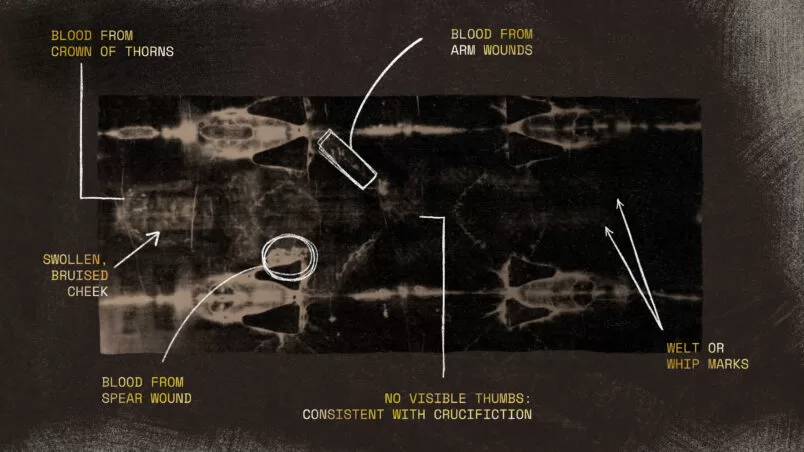
What are Blood Stains?
The Shroud of Turin displays various marks that appear to be blood stains. These include stains around the head, wrists, feet, and side of the torso. The stains are consistent with injuries from a crown of thorns, nails driven through the wrists and feet, and a spear wound to the side—details that align with the crucifixion of Jesus as described in the New Testament.
Discovery and Analysis
- Forensic Testing: Various tests, including those involving ultraviolet light, spectroscopy, and chemical analysis, have been conducted on the stains to determine their composition. These tests have identified the stains as being consistent with human blood, specifically type AB, which is a relatively rare blood type.
- Pathological Consideration: The placement, flow patterns, and matting of the blood have been analyzed by pathologists and forensic experts. They have noted that the stains follow realistic paths that gravity would dictate for a body positioned as the one on the Shroud, indicating a post-mortem origin for some of the blood flows.
Implications of Blood Stains
- Authenticity Arguments:
- Proponents of the Shroud’s authenticity argue that the complexity and anatomical correctness of the blood stains could not have been accurately fabricated by a medieval artist. The argument is based on the understanding that the knowledge of blood flow from specific wounds and the body’s positioning during and after crucifixion would not have been understood at the time the Shroud is believed to have been created.
- Forensic Detail:
- The details in the blood stains provide forensic clues that have been used to reconstruct the events leading to the formation of the image. For example, the blood stains around the head suggest the wearing of a cap or crown that caused bleeding, consistent with the Biblical account of the Crown of Thorns.
- Biological and Chemical Analysis:
- Studies have found high levels of bilirubin in the blood stains, a compound that the body produces more of under conditions of severe stress and trauma. This detail supports the theory that the person whose image is on the Shroud suffered a painful death.
The blood stains on the Shroud of Turin continue to be a focal point of both scientific investigation and theological debate. They present a convergence of forensic science, historical inquiry, and religious tradition, each adding depth to the discussions surrounding this enigmatic artifact. Whether viewed as evidence of a genuine relic or a subject of historical and artistic fascination, the blood stains significantly contribute to the ongoing mystery of the Shroud.
#6 Lack of Directional Brush Strokes
The sixth phenomenon associated with the Shroud of Turin is a critical aspect that has fueled debate about how the image on the Shroud was formed. This detail challenges the notion that the Shroud is a painted or artificially created artifact.
What are Directional Brush Strokes?
Directional brush strokes refer to the visible traces left by a brush or other application tools when paint, dye, or another medium is applied to a surface. These strokes can generally reveal the methods and techniques used by an artist, including the direction and sequence in which the medium was applied.
Discovery and Analysis
- Microscopic Examination: High-magnification microscopic analyses conducted by researchers have not revealed any evidence of pigments, dyes, or typical artistic media that would be used to paint an image. Importantly, these examinations also show no directional strokes that would suggest the image was applied with a brush or any tool.
- Material Studies: Further chemical and physical analyses have shown that the image is not superficial (i.e., sitting on top of the fabric’s surface) but rather a part of the fabric itself. The coloration of the fibers is due to changes at the molecular level, not due to material applied onto the surface of the cloth.
Implications of Lack of Directional Brush Strokes
- Challenges to the Forgery Theory:
- The absence of directional brush strokes is one of the strongest arguments against the theory that the Shroud is a medieval painting. If the image had been created using known artistic techniques of any era, traces of the application method would likely be detectable.
- Advanced Understanding of Image Formation:
- The unique nature of the image formation suggests a method not understood or reproducible with known artistic technologies of the past or present. This has led researchers to consider other hypotheses, such as chemical interactions, radiation, or other physical processes that might have created the image.
- Scientific Inquiry and Interdisciplinary Research:
- This phenomenon has attracted interest from chemists, physicists, and material scientists, as well as historians and art experts, all working to understand the possible mechanisms that could cause such an image to form without direct, intentional application of pigments or dyes.
The lack of directional brush strokes on the Shroud of Turin plays a crucial role in the debate over its origin. This detail challenges traditional understandings of how historical artifacts were created and invites a broader spectrum of scientific disciplines to explore the possibilities of image formation. Whether one views it as a sacred relic or a historical puzzle, the absence of brush strokes on the Shroud remains a compelling aspect of its study, pushing the boundaries of art history, forensic science, and materials analysis.
#7 Image Formation
The seventh phenomenon is arguably one of the most mysterious and debated aspects. The precise mechanism through which the image was imprinted on the Shroud remains a topic of considerable scientific intrigue and discussion.
What is Image Formation on the Shroud?
Image formation refers to how the detailed, three-dimensional likeness of a human form appears on the Shroud of Turin. The image is superficial, affecting only the topmost fibers of the cloth, without any pigment or directional application marks. It displays a negative photographic quality and contains distance information that allows for three-dimensional reconstruction.
Discovery and Analysis
- Characteristics of the Image: The image on the Shroud is not replicated anywhere in the world of art or science. It is a full-body image, front and back, depicting a man who appears to have suffered physical trauma consistent with crucifixion. The image is only visible in the very top fibers of the cloth and has not penetrated the underlying threads.
- Scientific Examinations: Over the years, various scientific techniques, including spectroscopy, ultraviolet light, infrared scanning, and more, have been employed to analyze the fabric and the image. These studies have shown that the image is not made by any known substance like paint, dye, or other typical artistic mediums.
Implications of Image Formation
- Mechanism Theories:
- Chemical Reactions: Some researchers suggest that a chemical reaction, possibly involving ammonia from perspiration and aloe and myrrh (reported to be used in the burial process), could have created a reaction with the cellulose in the linen to imprint the image.
- Radiation Hypotheses: Others propose that some form of radiant energy, like a burst of light or radiation, could explain the superficial nature of the image. This theory often connects with the idea that some form of miraculous event might have caused such an emission.
- Contact Image Transfer: Another hypothesis posits that the image was formed by direct contact between the cloth and a body covered in substances that could promote image formation through natural processes.
- Lack of Reproducibility:
- A major point of interest is that no one has been able to replicate the image fully using either ancient or modern technology, which adds to the mystery and fuels various theories about supernatural influences.
- Religious and Historical Significance:
- The unique properties of the image formation have been cited in discussions regarding the Shroud’s authenticity and its possible connection to the historical figure of Jesus Christ. This ties the scientific inquiry into the Shroud closely with theological considerations.
The image formation on the Shroud of Turin remains one of the greatest enigmas in the study of religious artifacts. It intersects faith, science, history, and art in ways that few other topics do. Whether viewed through a religious, scientific, or historical lens, the process through which the image appeared on the Shroud continues to be a compelling puzzle that invites deeper investigation and multidisciplinary research.
#8 The Cloth’s Weaving and Material
The eighth phenomenon focuses on the unique textile characteristics of the Shroud. The Shroud’s linen fibers are woven in a specific three-to-one herringbone twill pattern that distinguishes it from most medieval textiles.
What is the Cloth’s Weaving and Material?
The Shroud of Turin is made from linen, a textile made from the fibers of the flax plant. The cloth itself is woven in a herringbone pattern, a sophisticated twill weave where the direction of the twill reverses at regular intervals to create a distinctive V-shaped design. This pattern is more complex and generally considered more costly to produce than simpler weaves.
Discovery and Analysis
- Textile Examination: Historical and textile experts have studied the weave and material of the Shroud to determine its origin and age. The three-to-one herringbone twill weave is not only rare but also suggests a high level of craftsmanship.
- Radiocarbon Dating: In 1988, radiocarbon dating tests were performed on samples of the cloth, suggesting a date range of 1260 to 1390 AD. However, these results have been contested due to concerns about contamination and the selection of the sample area, which may have been repaired in the Middle Ages.
Implications of the Cloth’s Weaving and Material
- Indication of High Quality:
- The sophisticated weave pattern indicates that the cloth was an expensive and high-quality item, suggesting it would have been a significant purchase at the time it was made. This aligns with the theory that if it were used as a burial shroud, it was intended for someone of considerable importance.
- Historical Context:
- The quality and style of the weave can provide clues about the textile technology available during the time it was produced. Textile experts can compare the weave of the Shroud with other known textiles from various periods to help place it within a historical context.
- Challenges to the Medieval Forgery Theory:
- The complexity and cost of producing such a cloth could challenge the theory that the Shroud is a medieval forgery. Critics of the forgery theory argue that creating a sophisticated forgery using such an expensive and finely woven material might not have been feasible or logical for a medieval artist.
The weaving and material of the Shroud of Turin add another layer of complexity to its study. The textile’s quality, weave, and the controversies surrounding its dating continue to fuel debates about its origins, age, and the authenticity of the Shroud as a relic. Whether as an artifact of religious significance or a subject of historical textile study, the Shroud’s cloth continues to be a focal point of fascination and scholarly research.
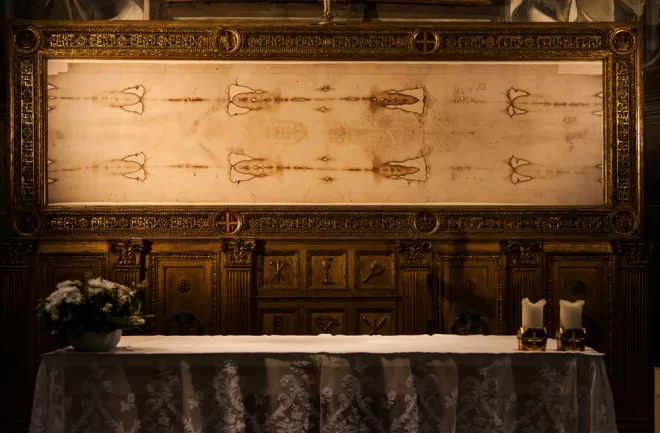
#9 Chemical Makeup
The ninth phenomenon is a crucial aspect that delves into the molecular composition of the image on the Shroud. Understanding the chemical properties of the image helps in theorizing how the image might have been formed.
What is the Chemical Makeup of the Image?
The image on the Shroud of Turin is notable for its lack of pigments or dyes and its presence on the very top fibers of the linen cloth. The coloration of these fibers is due to changes at the molecular level rather than an application of external substances.
Discovery and Analysis
- Material Studies: Several studies have been conducted to analyze the fibers where the image is present. These studies have shown that the image areas do not contain any pigments or dyes typically used in painting or drawing.
- Chemical Tests: Advanced chemical tests, such as spectroscopy, have been used to determine the composition of the image areas. The tests reveal that the image is a result of oxidation, dehydration, and conjugation of the polysaccharide structure of the cellulose of the linen itself.
Implications of Chemical Makeup
- No Evidence of Artistic Materials:
- The absence of traditional artistic materials like pigments and binders in the image areas strongly suggests that the image was not painted. This finding is critical in discussions regarding the authenticity of the Shroud and the theories of it being a medieval forgery.
- Mechanism of Image Formation:
- The changes in the chemical structure of the linen fibers suggest a reaction that caused oxidation and dehydration at the topmost fibers. This could be indicative of a reaction from body decomposition, a burst of energy or light, or contact with substances that could catalyze such a reaction.
- Theories such as a Maillard reaction, where gases from a decomposing body might have reacted with the sugars on the linen, have been proposed to explain this phenomenon.
- Durability and Faintness of the Image:
- The superficial nature of the image (affecting only the topmost fibers) contributes to its overall faintness and the detailed yet delicate appearance. This also means that the image is incredibly vulnerable to wear and environmental factors, which could affect attempts at preservation and further analysis.
The chemical makeup of the image on the Shroud of Turin is a foundational element in understanding its formation. The unique characteristics of the image at the molecular level provide compelling evidence against it being a painted forgery. However, the exact nature of the chemical reactions that led to the image’s formation remains a subject of active research and spirited debate among scientists, historians, and theologians.
#10 Consistency with Roman Crucifixion Methods
The last phenomenon in this post associated with the Shroud of Turin highlights the alignment of the marks on the Shroud with historical and archaeological understandings of Roman crucifixion practices. This consistency is crucial in discussions about the Shroud’s authenticity and the historical context of the image it bears.
What Does Consistency with Roman Crucifixion Methods Imply?
This phenomenon refers to the alignment of the wounds and blood stains on the Shroud with the known methods of Roman crucifixion. The positioning of the nails, the nature of the wounds, and the patterns of blood flow are consistent with what is historically understood about how the Romans executed crucifixion, a common punishment for criminals during the era.
Discovery and Analysis
- Forensic Examination: Experts in forensic medicine and pathology have examined the Shroud, focusing on the patterns and locations of blood stains and wounds. They’ve noted that the marks on the wrists and feet are consistent with nail wounds, and the side wound aligns with the account of a spear thrust described in the Biblical narrative of Jesus’ crucifixion.
- Historical and Archaeological Corroboration: Studies in Roman history and archaeology confirm that the methods depicted on the Shroud (e.g., nailing through the wrists rather than the palms) are historically accurate. These findings are supported by archaeological discoveries of crucified remains, such as those of Yehohanan, a man crucified in the first century in Jerusalem.
Implications of Consistency with Roman Crucifixion Methods
- Historical Accuracy:
- The accurate representation of crucifixion on the Shroud suggests a detailed knowledge of Roman execution methods. This level of detail might be beyond the knowledge of a medieval forger, suggesting the Shroud could be genuinely linked to a historical crucifixion from the Roman era.
- Support for Authenticity Claims:
- For those who believe the Shroud wrapped the historical Jesus, the consistency with Roman crucifixion methods is seen as supporting evidence. It aligns the Shroud with the first-century Judean context in which Jesus was crucified.
- Insight into Crucifixion Practices:
- The Shroud provides valuable insights into the brutal nature of crucifixion as a form of capital punishment in ancient Rome, serving as a tangible link to past practices and augmenting historical and biblical scholarship.
The consistency of the wounds and blood stains on the Shroud of Turin with Roman crucifixion methods adds a significant dimension to its study, intersecting fields of history, archaeology, forensics, and theology. Whether one views it as an artifact of devotion, a historical relic, or a subject of scientific inquiry, the details of crucifixion present on the Shroud continue to engage a wide array of scholars and the public, contributing to the ongoing fascination with this enigmatic cloth.
My Conclusion
Something miraculous happened to the body that was wrapped in this shroud. Something that is theorized as an incomprehensible release of radiant energy, possibly light or heat that only lasted a nano-second turn the fibers yellow without burning through the linen itself. Combine this with the empty tomb, the witnesses of his glorified body, and His own prophecy that he would rise again in 3 days and you have one amazingly consistent testimony.
I hope this article intrigued you and helped you reimagine the historicity of our risen Savior. The gospel of the Christ as written in 1 Corinthians 15:1-4 (KJV) – “Moreover, brethren, I declare unto you the gospel which I preached unto you, which also ye have received, and wherein ye stand; By which also ye are saved, if ye keep in memory what I preached unto you, unless ye have believed in vain. For I delivered unto you first of all that which I also received, how that Christ died for our sins according to the scriptures; And that he was buried, and that he rose again the third day according to the scriptures” Amen
Sources
https://www.shroudresearch.net/
https://shroud3d.com/introduction/image-qualities-of-the-shroud-of-turin/
https://www.raydowning.com/blog/2016/2/15/the-3d-information-on-the-shroud-of-turin

Jerry Goins
